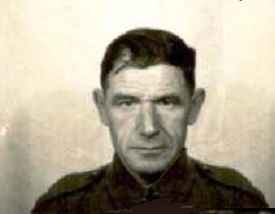SCOTT, Walter
| Service Number: | SX7684 |
|---|---|
| Enlisted: | 24 June 1940 |
| Last Rank: | Private |
| Last Unit: | 1st Depot Battalion |
| Born: | Yorkshire, England, 7 May 1901 |
| Home Town: | Thebarton (Southwark), City of West Torrens, South Australia |
| Schooling: | Not yet discovered |
| Occupation: | Cook and Labourer |
| Died: | 6 July 1956, aged 55 years, cause of death not yet discovered, place of death not yet discovered |
| Cemetery: |
Centennial Park Cemetery, South Australia Derrick Gardens, Centennial Park Cemetery, Path 3 Grave 29. |
| Memorials: |
World War 2 Service
| 24 Jun 1940: | Enlisted Australian Military Forces (WW2) , 2nd/48th Infantry Battalion | |
|---|---|---|
| 3 Jul 1940: | Involvement Private, SX7684 | |
| 3 Jul 1940: | Enlisted Adelaide, SA | |
| 3 Jul 1940: | Enlisted Australian Military Forces (WW2) , Private, SX7684, 1st Depot Battalion | |
| 18 Mar 1942: | Discharged | |
| 18 Mar 1942: | Discharged Australian Military Forces (WW2) , Private, SX7684, 1st Depot Battalion |
Answered the Call.
Walter was born in Hull, part of Yorkshire, England, before coming to South Australia where he lived in Thebarton with his wife Henrietta. Walter worked as both a cook and labourer when he enlisted on the 24th June 1940 to serve in WWII. At the time he gave his birthdate as on the 7th May 1901 and was therefore 39-year-old. In later statutory documents, having lost his precious ‘Returned from Active Service’ badge, he perhaps more accurately gave his date of birth as in the year 1888 and therefore his age at enlistment as 51. This is also borne out on the age given on his headstone.
Walter was allocated the number SX7684 and placed in the newly formed 2/48th Battalion, spending his early days in the pavilions, part of the (now) Royal Adeliade Showgrounds. He and the other new enlistees then undertook intensive training at Woodside in the Adelaide Hills.
Almost immediately Walter’s culinary skills were recognised with his grading to being a Group II Cook. Pre-embarkation leave followed before Walter then sailed on the Stratheden on the 7th November, arriving in the Middle East on the 17th December. He was to become one of the highly respected and admired rats of Tobruk. Ironically, the term was designed to destroy morale and encourage the soldiers to surrender. It had the opposite effect and was immediately seized on by the soldiers as an unofficial badge of honour. The heat, dust, flies and conditions of war contributed to Walter being diagnosed with chronic deafness in August the following year, causing him to be hospitalised. Inevitably he was adjudged as being permanently unfit for service, embarking for return to Australia in October ’41.
Soon after arriving by ship in Port Adelaide in November, Canberra was encouraging returning soldiers to ensure their disabilities were recorded before they returning to civilian life, thus enabling them to claim pensions and support from the Repatriation Department. Over the next three months, Walter spent time at Kapara homestead, a convalescing home run by the Red Cross at Glenelg and Wayville Hospital.
At the time, a Tobruk Day march was held on the 19th November, moving through Adelaide’s streets to the War Memorial, with a huge crowd of over 2,000 in attendance. It was the first large parade of returned men seen in Adelaide and was organised to commemorate Tobruk Day as well as being part of an intensive AIF recruiting campaign.
Walter was finally discharged on the 18th March ’42. His overseas service made him eligible for civilian clothes at this time.
According to his headstone, 63-year-old Walter died on the 6th July 1956. He now rests in the Derrick Gardens, Centennial Park Cemetery, Path 3 Grave 29. Henrietta is also buried in the same cemetery, Catholic A Path AW Grave 579.
Researched and written by Kaye Lee, daughter of Bryan Holmes SX8133, 2/48th Battalion.
Submitted 16 August 2025 by Kaye Lee











